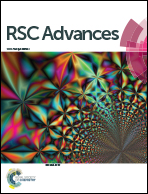Thickness-controllable coating of SiO2 on Co microspheres with tunable electromagnetic properties and enhanced oxidation resistance†
Abstract
A modified Stöber method was utilized for coating SiO2 on Co microspheres with tunable thickness as a filler for electromagnetic absorbing coatings with enhanced oxidation resistance. Co microspheres with diameters of 1.5–3.5 μm were prepared using an aqueous-reduction process, and Co@SiO2 core–shell microspheres with different shell thicknesses were subsequently fabricated by a modified Stöber method using tetraethyl orthosilicate (TEOS) as a Si source. The phase, morphology, and structure of composite microspheres were characterized by X-ray diffraction (XRD), scanning electron microscopy (SEM), energy dispersive X-ray spectroscopy (EDS) and thermogravimetric analysis (TGA). Both ε and μ of Co@SiO2 microspheres increase with the increasing filling ratio. No strong eddy current effect induced by local agglomeration was observed as the presence of a SiO2 shell protects the Co particles from agglomeration and the filling ratio is up to 45 vol%. Due to the presence of the SiO2 shell, the core–shell Co@SiO2 composite microspheres exhibit better antioxidation capability than that of pure Co microspheres. The oxidation temperature of Co@SiO2 is up to 720 °C, much higher than that of Co microspheres (380 °C). The effects of SiO2 shell thicknesses and annealing treatment on microstructure evolution and on EM parameters of Co@SiO2 composites were also investigated.


 Please wait while we load your content...
Please wait while we load your content...